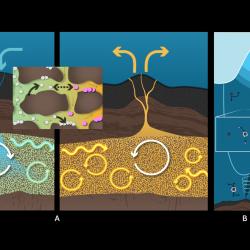NASA’s Webb Telescope Lifts Veil on Common but Mysterious Type of Exoplanet
University of Maryland researchers caught a rare glimpse of the atmosphere of a sub-Neptune—a type of exoplanet often obscured by haze and clouds.

Though they don’t orbit around our sun, sub-Neptunes are the most common type of exoplanet observed in our galaxy. These small, gassy planets are shrouded in mystery—and often, a lot of haze—but a new University of Maryland-led study published in Astrophysical Journal Letters highlights an exception: the exoplanet TOI-421b.
The researchers theorized that TOI-421b wouldn’t have clouds or hazes because of its temperature range—and they were right. Using NASA’s James Webb Space Telescope (JWST), they were able to get a clear view of the exoplanet, enabling them to detect water vapor and possibly carbon monoxide and sulfur dioxide in its atmosphere.
“I had been waiting my entire career for Webb so that we could meaningfully characterize the atmospheres of these smaller planets,” said Eliza Kempton, a UMD astronomy professor and principal investigator of the new study. “By studying their atmospheres, we’re getting a better understanding of how sub-Neptunes formed and evolved, and part of that is understanding why they don't exist in our solar system.”
A surprising finding
Before JWST, most sub-Neptune atmospheres appeared to have flat or featureless transmission spectra. This means that when scientists observed the spectrum of the planet as it passed in front of its host star, instead of seeing spectral features—chemical fingerprints revealing the atmosphere’s composition—they saw only a flat-line spectrum. This led astronomers to conclude that certain sub-Neptunes were likely highly obscured by clouds or hazes.
In their latest study of TOI-421b, researchers used Webb to see features that were previously difficult to capture.

“We saw spectral features that we attribute to various gases, and that allowed us to determine the composition of the atmosphere,” said the study’s first author, UMD astronomy Ph.D. student Brian Davenport. “Whereas with many of the other sub-Neptunes that had been previously observed, we know their atmospheres are made of something, but they're being blocked by haze.”
The team found water vapor in the exoplanet’s atmosphere, as well as tentative signatures of carbon monoxide and sulfur dioxide. There are also molecules they didn’t detect, such as methane and carbon dioxide. From the data, they inferred that a large amount of hydrogen is present—a lightweight atmosphere that caught the researchers by surprise.
“We had recently wrapped our minds around the idea that those first few sub-Neptunes observed by Webb had heavy-molecule atmospheres, so that had become our expectation,” Kempton said. “And then we found the opposite.”
The findings suggest that TOI-421b may have formed and evolved differently from the cooler sub-Neptunes observed previously.
Is TOI-421b unique?
TOI-421b’s hydrogen-dominated atmosphere is also interesting because it mimics the composition of its host star, according to Kempton.
“If you just took the same gas that made the host star, plopped it on top of a planet's atmosphere and put it at the much cooler temperature of this planet, you would get the same combination of gases,” Kempton said. “That process is more in line with the giant planets in our solar system, and it is different from other sub-Neptunes that have been observed with Webb so far.”
Aside from being hotter than other sub-Neptunes previously observed with Webb, TOI-421b orbits a sun-like star. Most of the other sub-Neptunes that have been observed so far orbit smaller, cooler stars called red dwarfs.
To find out if TOI-421b is emblematic of hot sub-Neptunes orbiting sun-like stars or if exoplanets are just extremely diverse, the researchers would like to observe more hot sub-Neptunes. In doing so, they hope to gain insights into the formation and evolution of these common exoplanets.
“We've unlocked a new way to look at these sub-Neptunes,” Davenport said. “These high-temperature planets are amenable to characterization. So by looking at sub-Neptunes of this temperature, we're perhaps more likely to accelerate our ability to learn about these planets.”
###
In addition to Kempton and Davenport, co-authors affiliated with UMD’s Department of Astronomy include Research Professor Drake Deming, former postdoc Matej Malik, postdoc Matt Nixon, Guangwei Fu (M.S. ’19, Ph.D. ’22, astronomy) and Jegug Ih (Ph.D. ’24, astronomy).
Their study, “TOI-421 b: A Hot Sub-Neptune with a Haze-Free, Low Mean Molecular Weight Atmosphere,” was published in Astrophysical Journal Letters on May 5, 2025.
This article was adapted from text provided by the Space Telescope Science Institute.
The study was supported by NASA (Contract No. NAS 5-03127) and the Space Telescope Science Institute. This article does not necessarily reflect the views of these organizations.







